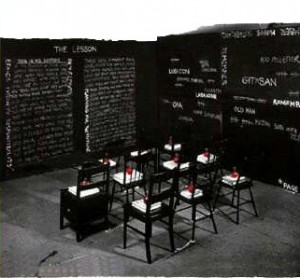On Sunday the 15th of September, I had the opportunity to visit the exhibition “Witnesses: Art and Canada’s Indian Residential Schools” currently held at the Morris and Helen Belkin Art Gallery in the UBC Vancouver campus. Having discussed the Truth and Reconciliation commission and the Indian residential schools in class before visiting the exhibit, I thought that I had a sound understanding of the events that transpired in Canada from 1880 to the end of the 20th century; however, seeing the exhibition showed me just how limited my understanding had been as to the true reality of the Canadian past.
As a collective whole, the exhibition delves into the tarnished past of Aboriginal children and their present reality as they seek to overcome the atrocities they faced in their youth. Robbed from the safety of their households, young children were thrown into the unfamiliar setting of white Canadian educational institutions and forced to forget their origins, values and beliefs in favor of the “superior” culture. In an attempt to establish a homogenized culture, the regime sought to “take the Indian out of the child”, regardless of the emotional, physical or mental cost to the native communities. Its aim was fundamentally to establish a factory of mass-produced children, passing them along its conveyor belt as you would products, twisting and turning until they were transformed into identical end products. As you walk through the exhibition, haunting portrayals of the children’s mental, physical, emotional and sexual abuse emerge, serving as a reminder of a Canada’s history of colonialism. Ultimately, the exhibition forced me to face the shattered remains of Aboriginal culture resulting from colonialist practices. It encouraged me to reflect on the power of art in portraying inescapable historic events and communicating the emotions attached to them, and thus to analyze some of the formal and iconographic features of the artwork in the exhibition. 
The Lesson, Joane Cardinal Schubert, 1989
One piece that gave me a better glimpse of the true nature of the colonialism and cultural indoctrination of “white” culture in the residential schools was The Lesson by Joane Cardinal Schubert. A chilling installation and performance artwork showcasing the classroom setting, the piece is partially enclosed on two walls by chalk boards, where bold, child-like writings recount descriptive stories of Aboriginal children. An almost palpable human presence is created by the contrasting forms of handwriting on the chalkboard, which collectively construct a disordered visual mosaic of the victims. Briskness, impatience and mounting anger are conveyed in the rapid chalk strokes and uneven lines of the writings (a quality also distinctly visible in Gina Laing’s Untitled pieces). Yet, in The Lesson, it is the incorporation of the victims’ names that gives the blur of Aboriginal faces a recognizable and tangible identity and thus urges the viewer to identify with them and their struggle. At the same time, the fixed, static and perfectly aligned rows of chairs in the central area of the installation foster an inhospitable, uninviting feeling, re-creating the restrictive environment within the residential schools. It is then that the viewer’s eyes drift to the upturned apples placed neatly on top of the books lying on the chairs, each with a steel hook emerging from its core. This piercing of a common symbol and hallmark of education perhaps alludes to the brutal destruction of the Aboriginal children’s spirit as they were absorbed into the education system.
Overall, I felt that the emphasis on the experiences of select victims in the artwork, coupled with the visible aesthetic impulse, works to construct a foreboding presence of the victims in the room. The generic Indian residential school classroom is re-incarnated before us in the exhibition, yet now it carries with it the weight of a horrific history attached to it and a responsibility for these stories to be told and passed on from one generation to the next.
